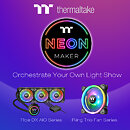Monday, April 27th 2020

Thermaltake NeonMaker now supports Riing Trio Fans and Floe DX AIO Series
Thermaltake, the leading PC DIY premium brand for Cooling, Gaming Gear, and Enthusiast Memory solutions, is now bringing some fantastic news for those who have been dying to try out the NeonMaker software without a set of Riing Quad Fans. The NeonMaker software now supports Riing Trio and the Floe DX series coolers. Now is the best chance for users to try out the NeonMaker with different Thermaltake products. Not only will you be able to personalize your lighting effects freely by utilizing the NeonMaker software, but you can also synchronize with the TT RGB Plus software to maximize the control of your RGB effects.
NeonMaker not only provides various default effects, but also lets users customize lighting colors, adjust effects' via the timeline, and lighting directions using the software editor. It also allows users to personalize their lighting effects on each LED, granting access to further customizable lighting options. There's no need to wait, enjoy all RGB related features on the NeonMaker software by using Riing Trio Fans and Floe DX series products.Availability, Warranty, and Pricing
Thermaltake Riing Trio RGB Fans and Floe DX RGB are available on ttpremium.com, Amazon and other online shops. Thermaltake Riing Trio RGB Fans and Floe DX RGB are backed by a 2-year warranty for coolers and supported by the Thermaltake worldwide customer service and technical support network. For up-to-date pricing of the Thermaltake Riing Trio RGB Fans and Floe DX RGB, please refer to the Thermaltake website or contact your local Thermaltake sales or PR representative.
For more details on NeonMaker and product information, please visit:
NeonMaker
NeonMaker
Riing Trio Fan Series
Riing Trio 12 three-fan Pack
Riing Trio 14 three-fan Pack
Riing Trio 20 Case fan
Floe DX RGB All-In-One Liquid Cooler Series
Floe DX RGB 240 mm AIO
Floe DX RGB 280 mm AIO
Floe DX RGB 360 mm AIO
Where to Buy
Riing Trio Fan Series
Riing Trio 12 three-fan Pack
Riing Trio 14 three-fan Pack
Riing Trio 20 Case fan
Floe DX RGB All-In-One Liquid Cooler Series
Floe DX RGB 240 mm AIO
Floe DX RGB 280 mm AIO
Floe DX RGB 360 mm AIO
NeonMaker not only provides various default effects, but also lets users customize lighting colors, adjust effects' via the timeline, and lighting directions using the software editor. It also allows users to personalize their lighting effects on each LED, granting access to further customizable lighting options. There's no need to wait, enjoy all RGB related features on the NeonMaker software by using Riing Trio Fans and Floe DX series products.Availability, Warranty, and Pricing
Thermaltake Riing Trio RGB Fans and Floe DX RGB are available on ttpremium.com, Amazon and other online shops. Thermaltake Riing Trio RGB Fans and Floe DX RGB are backed by a 2-year warranty for coolers and supported by the Thermaltake worldwide customer service and technical support network. For up-to-date pricing of the Thermaltake Riing Trio RGB Fans and Floe DX RGB, please refer to the Thermaltake website or contact your local Thermaltake sales or PR representative.
For more details on NeonMaker and product information, please visit:
NeonMaker
NeonMaker
Riing Trio Fan Series
Riing Trio 12 three-fan Pack
Riing Trio 14 three-fan Pack
Riing Trio 20 Case fan
Floe DX RGB All-In-One Liquid Cooler Series
Floe DX RGB 240 mm AIO
Floe DX RGB 280 mm AIO
Floe DX RGB 360 mm AIO
Where to Buy
Riing Trio Fan Series
Riing Trio 12 three-fan Pack
Riing Trio 14 three-fan Pack
Riing Trio 20 Case fan
Floe DX RGB All-In-One Liquid Cooler Series
Floe DX RGB 240 mm AIO
Floe DX RGB 280 mm AIO
Floe DX RGB 360 mm AIO


9 Comments on Thermaltake NeonMaker now supports Riing Trio Fans and Floe DX AIO Series
All that being said, I'm happy we Noctua fans (no pun intended!) are suddenly looking like the sensible ones in terms of how much we pay for our fans. $20 apiece is suddenly quite cheap!
And yeah, a 40 bucks mark up for a pretty light & software... I don't know, some wiring is messed up if one thinks that is somehow a good deal.
R&D costs on a fan? Lets be honest here, I seriously doubt if Thermaltake did even a tenth the level of testing on the fan's performance versus someone like Noctua. Dies, molds, production costs for the Riing Quad won't be anywhere out of what's normal for their previous RIING Trio or Duo, I can't know for sure, but I'm confident in saying they probably didn't have to pioneer some new manufacturing technique or method of injection molding. The Riing Quad isn't made from some new, still under patent, special plastic (I guarantee it's just the same ABS) or the Sterrox Liquid Crystal Polymer that Noctua developed and uses in their NF-A12x25 fans. Basically, the ONLY place I see increased R&D costs for a fan like this is in the software, but, if you have actually used the neon maker software (or any TT software), you'd know that it is pretty buggy at times (So it's not like they're spending tons on fully polishing it) and that the new neon maker software is mostly the features/code of their previous software with the addition of the timeline (which I'm sure wasn't too difficult to program).
....wait, are you a thermaltake employee....that's the only reason why someone would have said and done what you have....
I think Thermaltake's prices are a little out of touch with reality but it looks like they're trying to push their controller (which appears to be required to use the fans) with it too which could explain some of the cost. It's also 30-zones per fan between three separate rings. Thermaltake offers a more generic ARGB fan with fewer zones (I assume) which is $60 for a 3-pack, roughly what I would expect an RGB fan to go for. Even the low-end no-name brand ARGB fans seem to start at $15.
(Edit: Just found a 6-pack 120mm ARGB fan with controller/splitter for $41 on Amazon. $6.83 per fan isn't too shabby but I suspect it'll disappoint on performance and longevity.)
That said, at 2200 RPM they feel like
That is definitely a different experience from the 1450rpms.